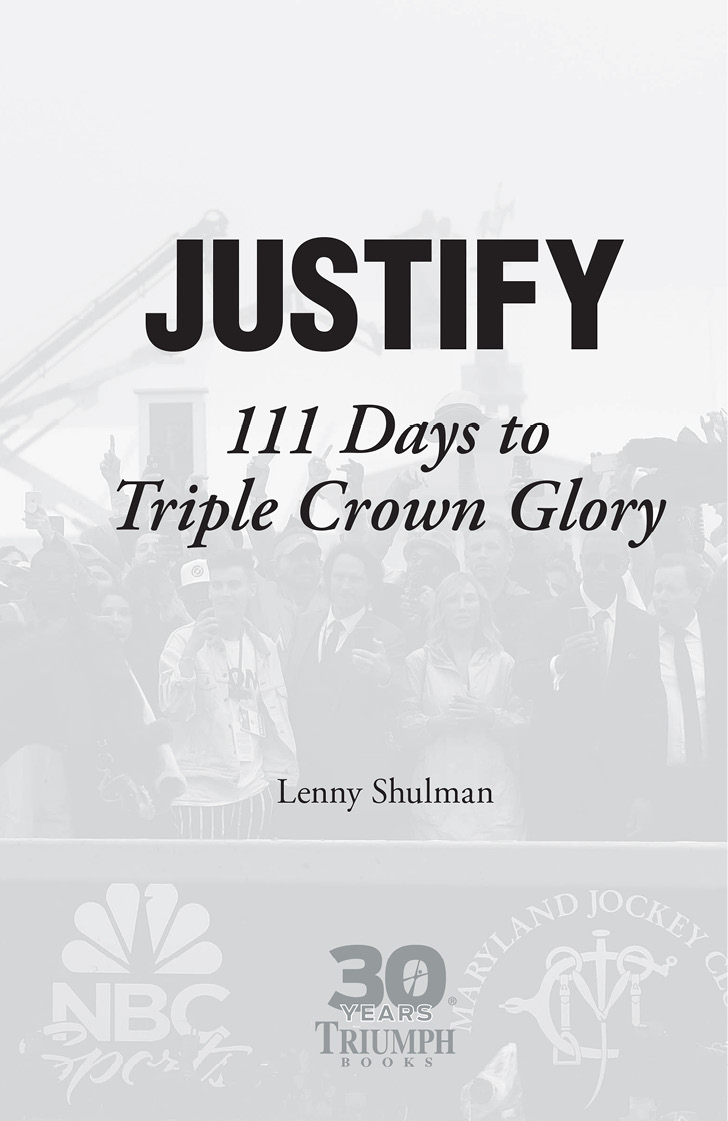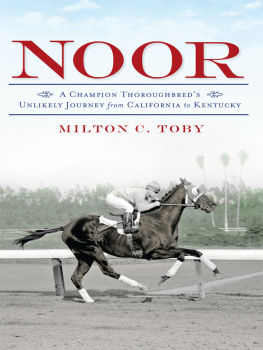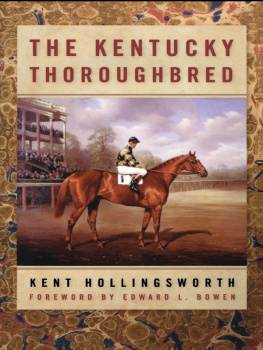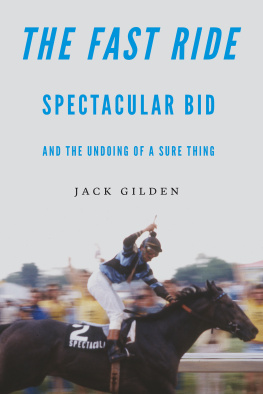
Contents
Foreword by Steve Haskin
You are about to embark on a journey unlike anything ever seen in Thoroughbred racing. It is a whirlwind journey that left greatness not to the stat sheet, but to the imagination, much like an unfinished Mozart concerto or a Degas pastel that was finished quickly in order to capture the essence of his subject.
Justify was his own subject and was able to capture his essence in only 111 days. Whether unfinished or not, it was a masterpiece that changed the course of racing history.
What Justify accomplished in some three and a half months during arguably the most meteoric rise in racing history is unprecedented. He will always be remembered as the horse who continually rewrote the history books, defying several significant historical trends of more than 100 years, including the much publicized Apollo Curse, becoming the first horse in 136 years to win the Kentucky Derby without having raced as a 2-year-old. To accomplish that off only three lifetime starts and then go on to sweep the Triple Crown is something we likely will never see again. And to do it after running the fastest fractions ever by a Kentucky Derby winner elevated him into a realm of his own.
Most horses with such little racing foundation would need time to recover from such an arduous task, but he came right back in two weeks, despite exiting the Derby with a bruised foot, and outdueled the previous years 2-year-old champion and Kentucky Derby runner-up, Good Magic, putting him away after racing eyeball to eyeball from the start. His Preakness victory proved to be a metaphor for his career, as he emerged from the dense fog like some ghostly shroud, with his white silks and white face. The Pimlico stretch, like that years Derby trail, was a blank canvas, with everyone waiting anxiously for that one special image to appear from seemingly out of nowhere.
His Belmont Stakes victory, just 111 days after his career debut, provided a curtain call to rival opening night of Hamilton on Broadway. Every single person in the audience knew they had witnessed history being made.
To put everything in proper perspective, Justify accomplished something in 16 weeks that it took all the previous Triple Crown winners an average of 11 months to accomplish.
And he did it racing on three fast tracks, two sloppy tracks, and one muddy track, while winning his six races at six different distances, from seven furlongs to a mile and a half.
Never before had we seen a horse exhibit such recuperative powers at that early an age. Despite the rigorous grind he was put through, Justify showed no ill effects, bouncing out of each race like a fresh horse; seemingly stronger than the race before. From his victory in the Santa Anita Derby to his Triple Crown sweep in the Belmont Stakes, he lost a total of three pounds. That is unheard of, especially for a 1,260-pound horse.
But in many cases, venturing into uncharted waters with a young, inexperienced horse and asking so much of those spindly legs comes with a price, and the Belmont was the last racing fans would see of Justify, which brings up the subject of his legacy. In addition to what he accomplished in what seemed a blink of the eye, he showed us that there is nothing unattainable, regardless of what history tells us. He made us realize that there no longer are worlds that cannot be conquered. He taught us that history books are not merely rule books and guidelines of how things should be done, but that there are always new pages to be written, as implausible as they may seem.
Justify proved that a great horse didnt need to win by large margins or break track records. He won under any conditions, at any racetrack, at any distance, and against all competition, and he did it without having a breather and with virtually no racing foundation under him. And, because of his whirlwind career, his grand appearance, and his will to win, he captured the publics heart and imagination, and was able to step out of the daunting shadow cast by American Pharoah.
There are a number of factors that determine how an individual is treated in the history books and how he or she will be remembered by future generations. There are the track and world records set by Secretariat, Dr. Fager, and Swaps. There are the staggering weights carried by Forego, Kelso, Discovery, Exterminator, and, again, Dr. Fager. There is the dominance over a long period of time by warriors such as John Henry, Kelso, and Exterminator. There are those rare iconic figures who transcend the Sport of Kings and become part of our culture, such as Man o War, Secretariat, and Seabiscuit. And, finally, there is the most exclusive of clubs, the 13 Triple Crown winners.
Although Justify belongs only in the final category, he will forever be remembered as the horse who established his own niche in the history books by changing the fabric of the sport. In short, he was a true revolutionary, accomplishing feats never believed possible in such a short period of time. By defying numerous historical trends, he no doubt altered the way future horses are trained in preparation for the classics.
In the pages that follow, you will be taken behind the scenes and meet the people and witness the events that set this extraordinary machine in motion. Those who bred him, sold him, purchased him, broke him, prepped him, trained him, owned him, and now stand him at stud, formed a continuous chain, each with the knowledge and gratification that they helped move this unique athlete along toward his place in history.
The legendary British and Irish race-caller Sir Peter OSullevan used to say whenever he witnessed a truly remarkable performance by a special racehorse, What manner of horse is this?
In the case of Justify, the answer to that question, again, is something left to the imagination.
Steve Haskin is a longtime Turf writer who has covered horse racing for 42 years and the Kentucky Derby/Triple Crown for 32 years. He has written six books on the sport, won numerous awards including six Red Smith Awards for his Kentucky Derby coverage, and in 2016 was elected to the National Museum of Racings Hall of Fame Media Roll of Honor.
Introduction
Horse racing, more than any other sport, embraces the inevitable comparison of heroes from different eras. Perhaps it is because of the importance of the pedigrees of the athletes, amassed over decades of carefully nourished bloodlines; or, simply, maybe it is the need for a good argument among fans who regularly back their opinions with money.
Was Secretariat superior to Man o War? Could Affirmed compete with Citation? Was Seattle Slew the equal of American Pharoah? Perhaps debates are not supposed to result in definitive answers; maybe their appeal is in the illusion that through opinion, we can break the code and think what we believe is the ultimate truth, and that we can then somehow know the unknowable.
The comet that streaked across the Thoroughbred racing world in 2018 is destined to become one of the most controversial unanswered questions in the sports annals. This is what we know about the 3-year-old colt Justify: he accomplished more in less time than any other Thoroughbred in U.S. racing history. He rewrote various pages of the record book. He is just the 13 th Triple Crown winner in the 100 years since the Kentucky Derby, Preakness, and Belmont Stakes have been grouped together as classic races; and only the second horse to win the Triple Crown while undefeated and also the first Triple Crown winner to retire undefeated.











